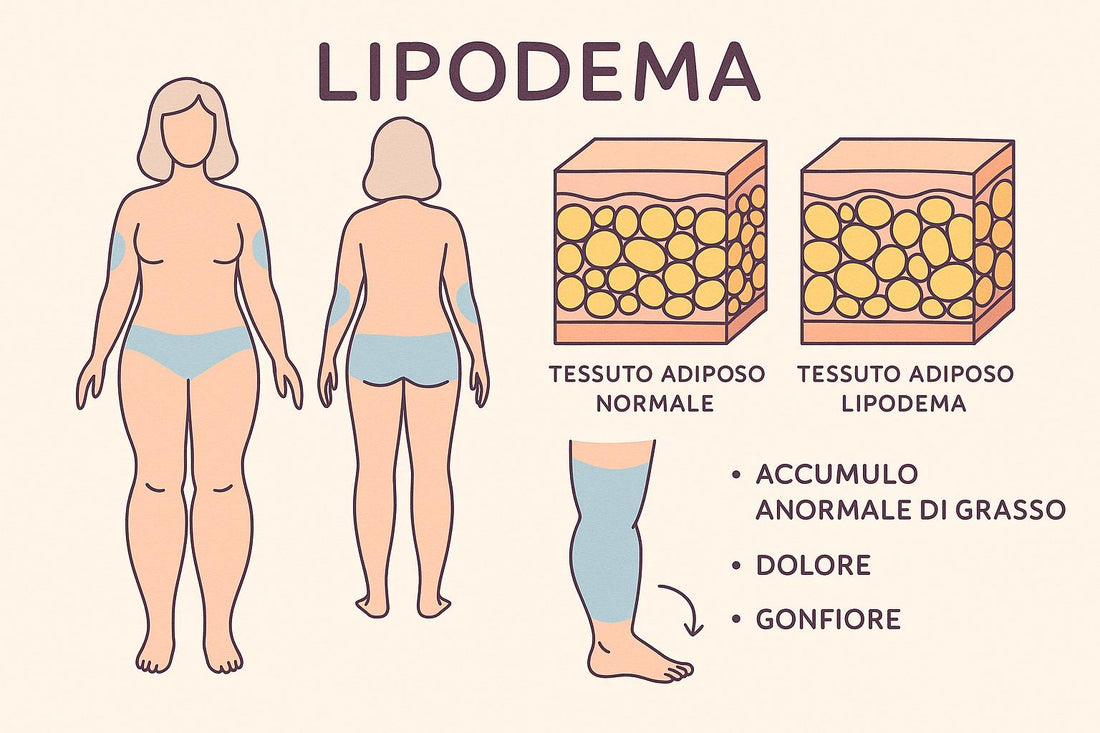
Lipedema: A Real Disease, Too Often Ignored
What is lipedema?
Lipedema is a chronic disease of adipose tissue that affects almost exclusively women, especially in phases of life related to strong hormonal changes (puberty, pregnancy, menopause). It is characterized by an abnormal and symmetrical accumulation of fat on the hips, thighs, buttocks, legs and sometimes arms, but not on the hands and feet.
Lipedema is often confused with obesity, lymphedema, or simple fluid retention, but it is a distinct pathological condition , with an inflammatory, microvascular, and, in some cases, lymphatic component.
Epidemiology and origin of the problem
According to recent studies, lipedema could affect between 10 and 15% of adult women , although the real numbers are probably underestimated due to poor knowledge of the disease.
The exact causes are not yet fully known, but it is believed that they play a role:
- genetic predisposition (in more than 60% of cases there are other affected women in the family)
- hormonal fluctuations
- the body's chronic inflammatory response
How does it manifest itself?
Lipedema has very specific symptoms, which include:
- Symmetrical and disproportionate accumulation of fat on the legs and/or arms
- Pain to the touch or even spontaneous, often described as burning or a feeling of constriction
- Easy bruising
- Sensation of heavy legs , especially after long hours of standing
- Secondary edema (swelling) that worsens with heat or during menstruation
- Difficulty losing localized weight despite diet and exercise
Stages of Lipedema
The disease tends to progress over time , passing through different stages:
- Stage 1 : Smooth skin, but thicker and more painful fat tissue
- Stage 2 : Skin with irregular appearance (orange peel), nodules under the skin
- Stage 3 : significant fat masses, marked deformations of the legs or arms
- Stage 4 (lipo-lymphedema): the lymphatic system is compromised, chronic edema occurs
Diagnosis: Why does it often arrive late?
Lipedema is not diagnosed by specific blood tests or imaging. It is a clinical diagnosis , based on observation, family history, and symptoms reported by the patient.
Unfortunately, many doctors do not easily recognize it, and this leads affected women to feel invisible or even guilty for a disorder that does not depend on their eating habits.
What Lipedema is NOT
- It's not obesity (you can be thin and have lipedema)
- It is not lymphedema (which involves feet and hands and has a different physiology)
- It's not temporary water retention
- It is not an aesthetic problem, but a disabling disease
Psychological and social impact
In addition to physical pain, lipedema causes psychological distress, reduced self-esteem, relationship difficulties and a sense of frustration . Many women feel judged, unheard or ridiculed, even by health workers. The diagnosis, when it finally arrives, is often experienced as a liberation.
Therapeutic approaches: what science says
Lipedema treatment is complex and personalized. There is currently no definitive cure, but it is possible to alleviate symptoms, slow progression, and improve quality of life .
1. Conservative therapy
- Targeted nutrition : Recent studies indicate that low-carb or ketogenic diets can reduce systemic inflammation and improve symptoms such as pain and swelling (Herbst KL, 2021).
- Gentle physical activity : walking, swimming, water aerobics, gentle yoga. High-impact exercise is not recommended.
- Physical therapies : manual lymphatic drainage, pressotherapy, compression bandages
- Custom-made graduated compression stockings (very useful in slowing down edema)
- Psychological support : often essential to accompany the management of the pathology
2. Surgery
Tumescent liposuction , performed only by specialists experienced in lipedema, has been shown to be effective in:
- reduce pathological fat mass
- reduce pain and bruising
- improve mobility
- slow the progression of the disease
Numerous longitudinal studies (Schmeller et al., 2012; Bauer et al., 2020) show persistent benefits even 10 years after the intervention.
The Role of Low Carb and Ketogenic Diets
More and more women with lipedema are finding benefit from a low-carb diet. Benefits include:
- Reduction of systemic inflammation
- Less water retention
- Better insulin response
- Improved pain and daily energy
Our artisanal low carb products are also suitable for those suffering from lipedema because they contain very few simple carbohydrates: they do not rapidly raise blood sugar levels, do not excessively stimulate insulin and do not fuel the cycle of chronic inflammation .
Concrete help in Italy: LIO Lipedema Italia
If you think you have lipedema or are looking for a point of reference to deal with it, in Italy there is LIO Lipedema Italia APS/ETS , an association founded in 2018 that deals with support, awareness and defense of the rights of people affected by lipedema.
LIO is made up of patients and caregivers who know the disease from the inside. It promotes scientific information, training for health workers, psychological support and actions for the recognition of lipedema in the LEA (Essential Levels of Assistance) of the National Health Service.
You can learn more, sign up or support their activities (even with 5x1000) by visiting the website https://lipedemaitalia.info .
Scientific sources
- Schmeller W. et al. (2012), Liposuction is an effective treatment for lipedema . Dermatol Surg.
- Bauer AT et al. (2020), Pathomechanisms of Lipedema: Inflammation, Fibrosis and Vascular Dysfunction . Int J Mol Sci.
- Herbst KL. (2021), Rare Adipose Disorders and the Importance of Early Diagnosis . Obes Med.
- Cornely ME. (2019), Guideline S1: Lipedema - Diagnosis and Treatment . J Lymphol.
Conclusion Lipedema is not a matter of aesthetics, but of health. Talking about it is the first step. Knowing it, recognizing it, dealing with it: you can. And today you also know who you can turn to: LIO Lipedema Italia can accompany you on this journey.
